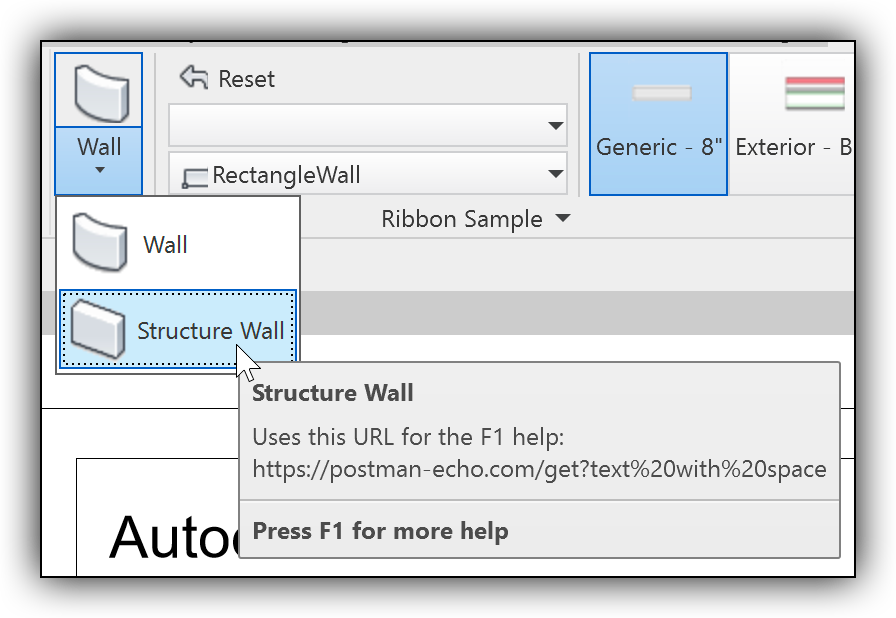
I am busy as ever in the Revit API discussion forum. Today, let's highlight a couple fo items that were not discussed there:
A colleague looked into an issue with ContextualHelp and wrote the following based on own tests and the info in the development ticket:
Using ContextualHelp you can provide a URL for any button that should be shown when the user clicks F1 while a ribbon button tooltip is displayed.
If the URL has a space character in the path, you usually encode it either as %20 or +.
That may cause an issue for ContextualHelp.
Let’s use this URL as an example:
postman-echo.com/get?text%20with%20space
First problem: if you use https, then https://accounts.autodesk.com/oAuth/OAuthRedirect will be called with a redirect to the actual URL you specified for F1 using the ContextualHelp object.
This will confuse and stall users.
Secondly: if, on top of that, the URL also contains a space (%20 or +), then you’ll get stuck on that webpage:
https://accounts.autodesk.com/oAuth/OAuthRedirect?oauth_consumer_key=1c27193f-af5e-4e7c-9847-06cd5c3c30ae&oauth_nonce=cd819e65f0ac476099e9c795a22c05a7&oauth_redirect_url=https%3A%2F%2Fpostman-echo.com%2Fget%3Ftext%2520with%2520space&oauth_signature=xl7aBEcj5lI%2FX28ozkvQ%2Ba163qg%3D&oauth_signature_method=HMAC-SHA1&oauth_timestamp=1600289858&oauth_token=bskZ8nJbcvBt%2FTyQvS%2FeImjP6pc%3D&oauth_version=1.0
It displays the following error message:
xoauth_problem=parameter_rejected&xoauth_parameters_absent=oauth_redirect_url&oauth_error_message=Invalid%20value%20for%20parameter%3Aoauth_redirect_url

You can reproduce this issue with any sample using the following code:
ContextualHelp contextualHelp = new ContextualHelp( ContextualHelpType.Url, "https://postman-echo.com/get?text%20with%20space" ); pushButton.SetContextualHelp(contextualHelp);
Both of the above-mentioned problems can be avoided by passing the link as http instead of https.
If the given website redirects from http to https, that won’t cause a problem:
ContextualHelp contextualHelp = new ContextualHelp( ContextualHelpType.Url, "http://postman-echo.com/get?text%20with%20space" ); pushButton.SetContextualHelp(contextualHelp);
I hope you find this useful as well.
Jay Merlan very kindly shared some insights on renaming shared parameters in his recent article on True or False: Shared Parameters Can Be Renamed.
As I pointed out in my comment on that post, the Revit development team discussed Jay's suggestions internally and say:
My perception is that we don't support renaming a shared parameter after loading into a project or a family.
We are discussing support for such a feature of 'unified parameters' in a future release of Revit.
Jay's article above explains very well why Revit customers want to rename them, and that is really helpful.
The steps above work well to generate a new family with the new name, and the references, like formulas within the family, are updated to the new name. But, when I try to load it to an existing project with old name parameters, it will be renamed back. That makes sense and that is how this workaround works. So, it only works for the projects and models without using the old parameters.
The fundamental problem with the current Revit implementation of shared params is the fundamental question: what does it mean to 'rename' a parameter?
Once the parameter definition .txt file has been consumed by Revit, you can rename a parameter in the .txt file all you like, regardless of what Revit considers correct. But, all docs where this file has already been consumed will have no idea of the new name. Which will clearly result in a mess, as the same parameter will appear under different names spread all over various projects and families.
In cases when two incarnations of the same parameter need to be merged (because it is the same parameter, after all), one incarnation will magically change its name – like in the Load Family case.
As far as we can tell, a problem like this can only be solved via some 'central source of truth', like a cloud-something.
I browsed through this tutorial on how to build a neural network from scratch with PyTorch and found it quite illuminating and inspiring. I wish I had more time to dabble with this kind of stuff!
Going under the hood of neural networks to learn how to build one from the ground up... The MNIST data set contains handwritten digits from zero to nine with their corresponding labels... Simply feed the neural network the images of the digits and their corresponding labels which tell the neural network that this is a three or seven... We just write the code to index out only the images with a label of three or seven. Thus, we get a data set of threes and sevens...